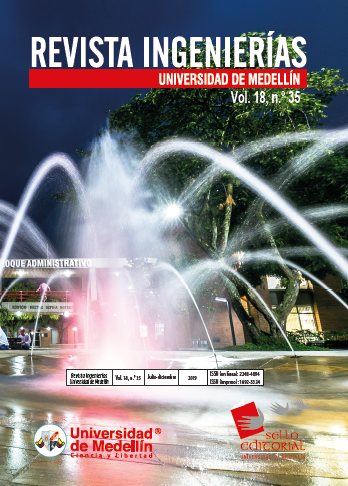Degradation of Ethylene Glycol Through Photo-Fenton Heterogeneous System
Main Article Content
Abstract
This work describes the ethylene glycol degradation in a photo-Fenton heterogeneous system. Iron-doped TiO2 photocatalysts prepared by different methods (incipient wet impregnation and sol-gel method), as well as the corresponding un-doped material were examined in this process. Different values of initial pH and H2O2 concentration were tested during the experiments. A lower photoactivity was observed for the un-doped materials than for the Fe-doped materials. Optimum results of initial pH and H2O2 concentrations were found to be 3.0 and 1,000 mg/L, respectively. Furthermore, the highest degradation percentage of ethylene glycol (61 %) was achieved for the material synthetized by sol-gel method. Such catalytic performance is explained on the basis of structural/morphological and electronic characterization results, reached by XRD, UV-vis DRS and XPS techniques. To the best of our knowledge, this is the first report related with the ethylene glycol degradation using Iron-doped TiO2 in a photo-Fenton heterogeneous system.
Article Details
References
[1] A. N. Ardila Arias, E. Arriola Villaseñor, J. Reyes Calle, E. Berrio Mesa, and G. Fuentes Zurita, 'Mineralización de etilenglicol por foto-Fenton asistido con ferrioxalato,' Rev. Int. Contam. Ambient., vol. 32, n.° 2, pp. 213-226, 2016. DOI: http://dx.doi.org/10.20937/RICA.2016.32.02.07
[2] B. D. McGinnis, V. D. Adams, and E. J. Middlebrooks, 'Degradation of ethylene glycol in photo Fenton systems,' Water Res., vol. 34, n.° 8, pp. 2346-2354, 2000. DOI: http://dx.doi.org/10.1016/S0043-1354(99)00387-5
[3] B. Dietrick McGinnis, V. Dean Adams, and E. Joe Middlebrooks, 'Degradation of ethylene glycol using Fenton’s reagent and UV,' Chemosphere, vol. 45, n.° 1, pp. 101-108, 2001. DOI: http://dx.doi.org/10.1016/S0045-6535(00)00597-X
[4] J. Araña, J. A. Ortega Méndez, J. A. Herrera Melián, J. M. Doña Rodríguez, O. González Díaz, and J. Pérez Peña, 'Thermal effect of carboxylic acids in the degradation by photo-Fenton of high concentrations of ethylene glycol,' Appl. Catal. B Environ., vol. 113-114, pp. 107-115, 2012. DOI: http://dx.doi.org/10.1016/j.apcatb.2011.11.025
[5] C. E. Díaz-Uribe, W. A. Vallejo L., and J. Miranda, 'Photo-Fenton oxidation of phenol with Fe(III)-tetra-4- carboxyphenylporphyrin/SiO2 assisted with visible light,' J. Photochem. Photobiol. A Chem., vol. 294, pp. 75-80, 2014. DOI: http://dx.doi.org/10.1016/j.jphotochem.2014.08.004
[6] T. Tachikawa et al., 'Visible Light-Induced Degradation of Ethylene Glycol on Nitrogen-Doped TiO2 Powders,' J. Phys. Chem. B, vol. 110, n.° 26, pp. 13158-13165, 2006. DOI: http://dx.doi.org/10.1021/jp0620217
[7] T. Aguilar et al., 'A route for the synthesis of Cu-doped TiO2 nanoparticles with a very low band gap,' Chem. Phys. Lett., vol. 571, pp. 49-53, 2013. DOI: http://dx.doi.org/10.1016/j.cplett.2013.04.007
[8] D. V. Wellia, Q. C. Xu, M. A. Sk, K. H. Lim, T. M. Lim, and T. T. Y. Tan, 'Experimental and theoretical studies of Fe-doped TiO2 films prepared by peroxo sol-gel method,' Appl. Catal. A Gen., vol. 401, n.° 1-2, pp. 98-105, 2011. DOI: http://dx.doi.org/10.1016/j.apcata.2011.05.003
[9] A. Lassoued, B. Dkhil, A. Gadri, and S. Ammar, 'Control of the shape and size of iron oxide (α-Fe2O3) nanoparticles synthesized through the chemical precipitation method,' Results Phys., vol. 7, pp. 3007-3015, 2017. DOI: http://dx.doi.org/10.1016/j.rinp.2017.07.066
[10] Y. Liu et al., 'Enhanced visible light photocatalytic properties of Fe-doped TiO2 nanorod clusters and monodispersed nanoparticles,' Appl. Surf. Sci., vol. 257, n.° 18, pp. 8121-8126, 2011. DOI: http://dx.doi.org/10.1016/j.apsusc.2011.04.121
[11] C. Yu, Q. Fan, Y. Xie, J. Chen, Q. shu, and J. C. Yu, 'Sonochemical fabrication of novel square-shaped F doped TiO2 nanocrystals with enhanced performance in photocatalytic degradation of phenol,' J. Hazard. Mater., vol. 237-238, pp. 38-45, 2012. DOI: http://dx.doi.org/10.1016/j.jhazmat.2012.07.072
[12] A. Montesinos-Castellanos and T. A. Zepeda, 'High hydrogenation performance of the mesoporous NiMo/Al(Ti, Zr)-HMS catalysts,' Microporous Mesoporous Mater., vol. 113, n.° 1-3, pp. 146-162, 2008. DOI: http://dx.doi.org/10.1016/j.micromeso.2007.11.012
[13] P. Reyes, H. Rojas, and J. L. G. Fierro, 'Kinetic study of liquid-phase hydrogenation of citral over Ir/TiO2 catalysts,' Appl. Catal. A Gen., vol. 248, no. 1-2, pp. 59-65, 2003. DOI: http://dx.doi.org/10.1016/S0926-860X(03)00148-0
[14] C. Adán, A. Bahamonde, I. Oller, S. Malato, and A. Martínez-Arias, 'Influence of iron leaching and oxidizing agent employed on solar photodegradation of phenol over nanostructured iron-doped titania catalysts,' Appl. Catal. B Environ., vol. 144, n.° 1, pp. 269-276, 2014. DOI: http://dx.doi.org/10.1016/j.apcatb.2013.07.027
[15] S. H. Lin, C. H. Chiou, C. K. Chang, and R. S. Juang, 'Photocatalytic degradation of phenol on different phases of TiO2 particles in aqueous suspensions under UV irradiation,' J. Environ. Manage., vol. 92, n.° 12, pp. 3098-3104, 2011. DOI: http://dx.doi.org/10.1016/j.jenvman.2011.07.024
[16] H. B. Hadjltaief, M. Ben Zina, M. E. Galvez, and P. Da Costa, 'Photo-Fenton oxidation of phenol over a Cu-doped Fe-pillared clay,' Comptes Rendus Chim., vol. 18, n.° 10, pp. 1161-1169, 2015. DOI: http://dx.doi.org/10.1016/j.crci.2015.08.004
[17] E. Martin Del Campo, R. Romero, G. Roa, E. Peralta-Reyes, J. Espino-Valencia, and R. Natividad, 'Photo-Fenton oxidation of phenolic compounds catalyzed by iron-PILC,' Fuel, vol. 138, pp. 149-155, 2014. DOI: http://dx.doi.org/10.1016/j.fuel.2014.06.014
[18] Z. Shiyun, Z. Xuesong, L. Daotang, and C. Weimin, 'Ozonation of naphthalene sulfonic acids in aqueous solutions: Part II - Relationships of their COD, TOC removal and the frontier orbital energies,' Water Res., vol. 37, n.° 5, pp. 1185-1191, 2003. DOI: http://dx.doi.org/10.1016/S0043-1354(02)00178-1
[19] Z. Shiyun, Z. Xuesong and L. Daotang, 'Ozonation of naphthalene sulfonic acids in aqueous solutions: Part I- Relationships of their COD, TOC removal and the frontier orbital energies,' Water Res., vol. 37, n.° 5, pp. 1237-1243, 2002. DOI: http://dx.doi.org/10.1016/S0043-1354(01)00331-1
[20] L. Türker, T. Atalar, S. GümüÅŸ, and Y. Çamur, 'A DFT study on nitrotriazines,' J. Hazard. Mater., vol. 167, n.° 1-3, pp. 440-448, 2009. DOI: http://dx.doi.org/10.1016/j.jhazmat.2008.12.134





